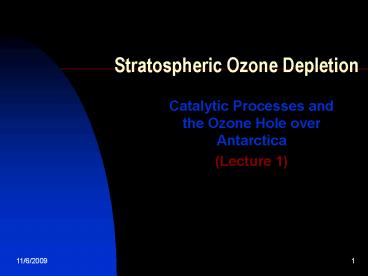Stratospheric Ozone Depletion - PowerPoint PPT Presentation
1 / 27
Title:
Stratospheric Ozone Depletion
Description:
The maximum density of ozone occurs at 25km over tropical areas, 21km over mid ... We are inadvertently increasing X conc by release of certain gases (especially ... – PowerPoint PPT presentation
Number of Views:33
Avg rating:3.0/5.0
Title: Stratospheric Ozone Depletion
1
Stratospheric Ozone Depletion
- Catalytic Processes and the Ozone Hole over
Antarctica - (Lecture 1)
2
Review on Atmospheric Layering
3
Review of Atmospheric Layering
4
Review UV Filtering
5
Variation of O3 Density
- The maximum density of ozone occurs at 25km over
tropical areas, 21km over mid-latitudes, 18km
over subarctic regions. - The O3 density is at a maximum when the product
of UV-C intensity and O2 conc is at a maximum. - Most O3 occurs between 15-35 km, the Ozone
Layer.
6
Review UV Filtering
7
Recent Skin Cancer Data
8
UV Index
9
Ozone Hole Over Antarctica
10
Ozone Hole Over Antarctica
11
Ozone Hole Seasonal Variation
12
Catalytic Processes- Ozone Destruction
- The X species are catalysts for O3 destruction in
stratosphere. - We are inadvertently increasing X conc by release
of certain gases (especially Cl-containing) at
ground level.
13
Review of Effect of Catalyst on Reaction Rates
14
Free Radicals
- In mechanisms I and II, X is a species with an
odd unpaired electron. - X can be NO?, Cl?, OH?, Br? H? (not O?)
- Cl? is the one of most concern!
- Read Box 2-1 Box 2-2
- Do 2-6 2-8
15
Free Radical Mechanism I
- Cl? O3 ? ClO? O2 Eact2 kJ/mol
- ClO? O? ? Cl? O2
- O3 O? ?? 2 O2 Eact 18.4kJ/mol
- Occurs in mid- and upper stratosphere.
- Cl? source can be natural or anthropogenic.
16
Free Radical Mechanism I
- Catalytic destruction of O3 can even occur in a
clean atmosphere (Involves NO?) - N2O rises from troposphere reacts with O.
- N2O O ? 2NO? (or SSTs)
- Then via Mechanism I
- NO? O3 ?? NO2? O2
- NO2? O? ? NO? O2
- O3 O? ? 2O2
17
Free Radical Mechanism I
- In the upper stratosphere, OH? is the dominant
free radical catalyzing O3 destruction. - CH4 or H2O react with excited oxygen, O
- CH4 O ? OH? CH3? (Do 2-9)
- Then via Mechanism I
- OH? O3 ? HOO? O2
- HOO? O? ? OH? O2
- O3 O? ?? 2O2
18
Activation Energies for Steps 1 2 of Mechanism
I with Different X
19
Relative Rates for O3 Decomposition Reactions via
Mechanism I Follow
- NO/NO2 gt uncatalyzed rxn ? Cl/ClO gt OH/HO2 gt
H/OH - Above data shows that smaller Eacts will not
always mean a faster reaction. Rates also depend
on conc of reactants. - For same reason, step 2 of Mechanism I is the
rate determining step!
20
Free Radical Mechanism II
- Mechanism I requires atomic O to complete the
cycle XO O ? X O2 - In lower stratosphere, atomic O conc is low
because UV-C doesnt penetrate that low. - Hence, most O3 loss in lower stratosphere occurs
via Mechanism II - X O3 ? XO O2
- X O3? XO O2
- XO XO ?? X X O2
- 2O3?3O2
21
Rates of O3 Formation and Destruction
- Rate of O3 formation depends upon O2, O3,
UV-light intensity at a given altitude. - Rate of O3 destruction is more complex. It
depends upon O3 x sunlight Intensity x X.
Each Cl? can destroy as many as 10,000 O3
molecules. (Do problem 2-10) - When above opposing rates are equal, then a
steady state is reached and O3 is constant.
22
Additional Reactions in Stratospheric Chemistry
- Temporary reservoirs of active species
- Interaction between catalytic cycles
- Null (do-nothing) cycles
- Initiation and termination reactions
23
Temporary Reservoirs
- Catalytically active species (NOx ClOx ) can be
temporarily converted into other substances - NO2? OH? ? HNO3
- Cl? CH4 ? HCl CH3?
- ClO? NO2? ?? ClONO2 ( sunlight)
- A sample regeneration reaction would be
- HCl OH? ? Cl? H2O
24
Interaction Between Cycles
- The different catalytic cycles all involve pairs
of catalysts, X and XO? These can interact, e.g. - NO? HOO? ? NO2? OH?
- Above would affect conc of reactants in both the
NO/NO2 OH/HO2 cycle
25
Null Cycles
- See Problem 2-7
- NO2? h?(?lt400 nm)?? NO? O?
- O? O2 M ? O3 M
- O3 NO? ?? NO2? O2
- When these are added, all species drop out!
- Sunlight is converted into kinetic energy.
26
Initiation Termination Reactions
- Initiation Reactions are usually Photochemical
- HNO3 h? ? NO2? OH?
- O3 h? ? O2 O?
- CH3Cl h? ? CH3? Cl?
- N2O O? ? 2NO?
- Last two reactions are principally biological in
origin.
27
Initiation Termination Reactions
- Termination reactions remove radicals from the
system. - (Examples)
- 2ClO? ? ClOOCl
- 2HOO?? H2O2 O2
- (Do RQ 11 18)































